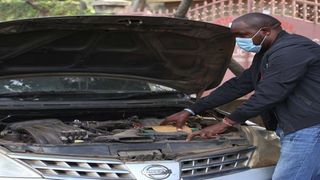
A taxi driver in South B, Nairobi, shows his car which runs on liquefied petroleum gas (LPG). Taxi drivers are embracing LPG cars to save costs.
| Kanyiri Wahito | Nation Media GroupNews
Premium
Kebs, insurers give thumbs-up for LPG-powered cars
What you need to know:
- LPG or AutoGas, is a mixture of gases present in natural gas or dissolved in oil.
- It has better combustive capabilities than regular fuel and is cheaper.
- The cost of converting your petrol propelled car to LPG in Kenya is about Sh55,000.
As the price of petrol continues to rise, taxi driver Peter Githaiga says he has found a way of reducing operating costs.
With the number of clients falling daily, Mr Githaiga took the decision to go for a new kind of fuel.
He added a Liquefied Petroleum Gas (LPG) tank to his car.
Mr Githaiga can now switch from petrol to gas whenever he wants. This, he says, saves up to 40 per cent of his earnings, compared to when he used petrol only.
A mixture of gases
“Fuel is becoming more expensive. Many drivers also have a commitment to go green,” Mr Githaiga told the Nation.
“The standard for application of/and compressed natural gases as fuel for internal combustion engines is in force and investors are at liberty to venture into this line of business,” the bureau said in an email to the Nation.
LPG or AutoGas, is a mixture of gases present in natural gas or dissolved in oil.
It has better combustive capabilities than regular fuel and is cheaper.
There are, however, safety concerns and the insurability of these vehicles.
Some motorists interviewed said the modifications may not be up to standard and could be danger-in-waiting.
Kenya Association of Insurers chief executive Tom Gichuhi said the firms have no problem with such cars as long as they have been approved by the government.
For Motorist Association of Kenya chairman Peter Murima, LPG is actually safer than petrol and diesel.
“It contributes to the reduction of greenhouse gases and improves the quality of air in urban centres,” he says.
How it works
LPG cars are bi-fuel. If the LPG tank runs out, the driver can switch to gasoline.
From the cylinder, the gas moves to a reducer where it is heated and turned to vapour. The vapour moves to the filter, where purified gas then goes to the injector lane, where it is distributed to the cylinders.
Proto Energy Ltd, which specialises in converting vehicles into hybrids, has partnered with leading European provider, Autogas Systems, trading as Otogas.
They have a pump station at Ruai junction, Nairobi.
According to the company, the Autogas LPG or CNG system has a number of important safety features, which include, a 3mm welded steel pressure cylinder which is stress-tested to many times its normal operating pressure prior to being installed.
Two electronically controlled shut-off solenoids -- on autogas LPG tank and on reducer under the bonnet -- stop the flow of the gas to the engine if the engine stops for any reason.
Pressure relief valves for the tank and the system prevent any pressure build-up that may damage the system, or be hazardous.
And lastly, there’s a double back-check valves to ensure autogas tight filling. Sealed compartments and venting around valves and pipe-work to ensure no LPG enters the interior of the vehicle and are approved components to ensure long service life.
Autogas tanks are designed with an automatic fill limiter (AFL) to prevent overfilling so the release of excess fuel during the refueling process is eliminated.
Resillient
On the safety measures, unlike the petrol spills, which will puddle under the car, any gas that might escape just dissipates into the air.
Proto Energy says that the Autogas tanks are designed to withstand even the most extreme conditions.
“The tanks are designed with 20 per cent unused volume to allow for any expansion of the LPG in hot conditions and that there is also a pressure relief valve that ensures that the internal tank pressure stays within safe tolerances, even when the tank may be exposed to an abnormal amount of heat,” says the company.
Gas can ignite just as easily as petrol, but it’s stored in a thick steel tank. Tests carried out by the Netherlands Organisation for Applied Scientific Research (TNO) confirmed that LPG tanks are safer than petrol tanks in an accident. In the event of a fire, occupants would have three times longer to escape than in a petrol car.
The cost of converting your petrol propelled car to LPG in Kenya is about Sh55,000.
Automobile Association of the UK says on its website that the fuel economy of LPG cars is about 20-25 per cent lower than regular petrol or diesel vehicles.
Empirically, the website adds, LPG-based vehicles produce 15 per cent less carbon dioxide, 30 per cent less carbon monoxide and 50 per cent less nitrogen oxides. As an additional benefit, LPG has a higher-octane rating providing greater performance than conventional gasoline and diesel, making it a popular alternative to oil-based fuels.
Globally, there were about 27 million autogas vehicles in 2019, a figure that is expected to triple by 2024, driven by the environmental benefits and relatively competitive cost, according to the UK website.





